Note: This is a guest post contributed by Mandarin Blueprint, a Chengdu-based company which guides students towards proficiency in the Chinese language around the world. The subject of this post, pinyin, is a crucial first step which any successful Chinese language learner will need to achieve mastery of. It is lengthy, so it might be best to refer to this post in more than one sitting!
Chinese Pinyin is a system of roman characters created through a committee led by 周有光 Zhōu Yǒuguāng. Despite using the same letters at the English alphabet (well, almost), there are some major differences in Chinese Pinyin. Furthermore, the name “Pinyin” comes from the pronunciation of the characters 拼音 pīnyīn. 拼 as a character alone means “to piece together”, with an alternate meaning of “to spell”. 音 means “sound”, so “piecing together” (aka “spelling”) “sound”! See, it all makes sense :-D.
Goals of this Article:
- Briefly touch on the Pinyin origin story
- Clarify the important focus points of the Chinese Pinyin chart
- Cover the most crucial inconsistencies in sound and spelling
- Give you confidence that you can successfully learn all of it properly in a (relatively) short amount of time
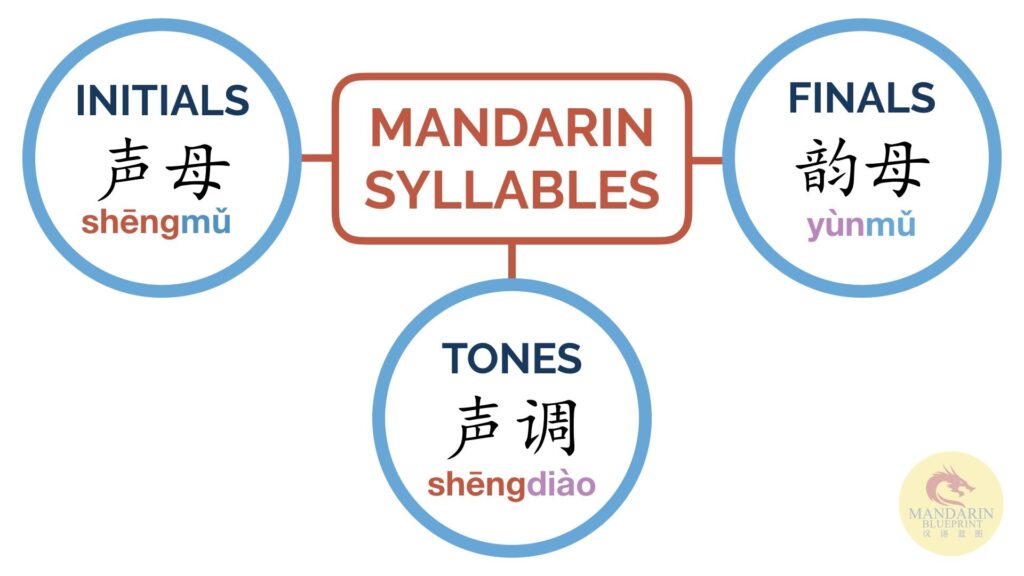
Before we jump in, a reminder that we’ll be using the terms “Initials”, “Finals” & “Tones” liberally throughout this post. If you aren’t familiar with these terms, check out the blog post we did about The Sounds of Mandarin Chinese.
THE CHINESE PINYIN ORIGIN STORY
We mentioned above that we’re only going to touch on this briefly, and that’s because knowing the origin story doesn’t help you learn Pinyin. That said, the question “but why would they spell it like that?” comes up all the time. If there’s anything all these years of studying & teaching Chinese Pinyin has taught us, it’s that some people just gotta know the why. Don’t feel bad though, we’re exactly the same way ;).
Thinking About Why Pinyin Was Made the Right Way
The simplest answer to any & all of the “but why is it spelled this way” question is that the Chinese alphabet wasn’t made for English speakers. We all know that when you are trying to solve a problem, it’s all in how you look at it. If your premise is “Chinese people made an alphabet to help English speakers learn Chinese” you will judge it more harshly. However, that was not the problem the creators of Pinyin were trying to solve.
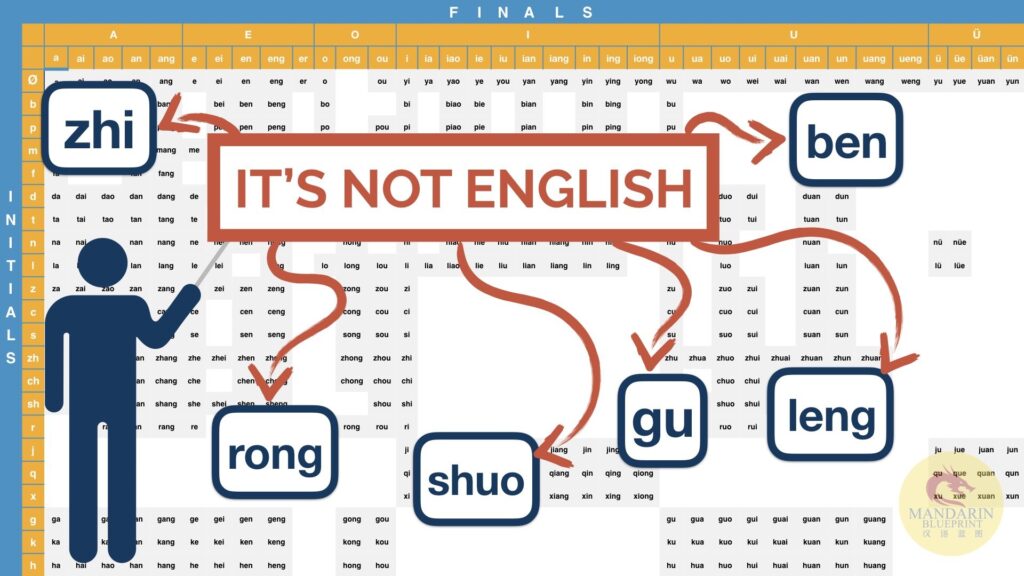
The Lay of the Land When Pinyin Was Invented
In the 50’s China had just been through quite a lot. Before WW2 there was civil war, which got put on pause during WW2 and then resumed after it. Yikes. Consequently there really wasn’t much of an economy once the new leadership took over in 1949, and the literacy rates were super low. Not too easy to study during war time. One of the reasons for the invention of Pinyin was to help raise literacy rates across the country. In other words, the Chinese alphabet was made for Chinese people, not westerners.
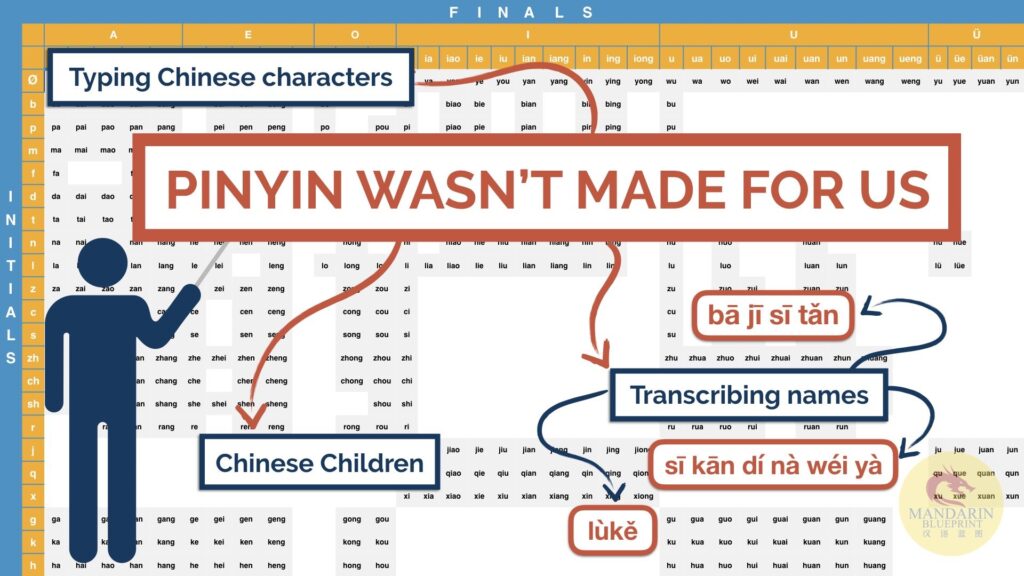
Not the Only System
Pinyin isn’t the only Chinese alphabet around, nor was it at the time of it’s invention. We find it a bit of a shame that they didn’t choose to go with the Yale Romanization, but no use crying over spilled milk. Furthermore, there are several other systems that are more intuitive and easier to read phonetically, but again, Pinyin was made with our phonetic instincts in mind. The fact is, Pinyin is the Mandarin Chinese alphabet romanization that is universally recognized across the mainland. Hence, using other systems should only be for help with learning pronunciation. Sadly other systems won’t be give you much practical help within the country.
THE CHINESE ALPHABET PINYIN CHART- Clarifying Points of Focus

First of all, take note of the fact that all the syllables of Mandarin Chinese fit onto one A4 page. That should be your first sign that conquering Mandarin Pinyin & pronunciation is an achievable goal.
CHINESE PINYIN BASICS
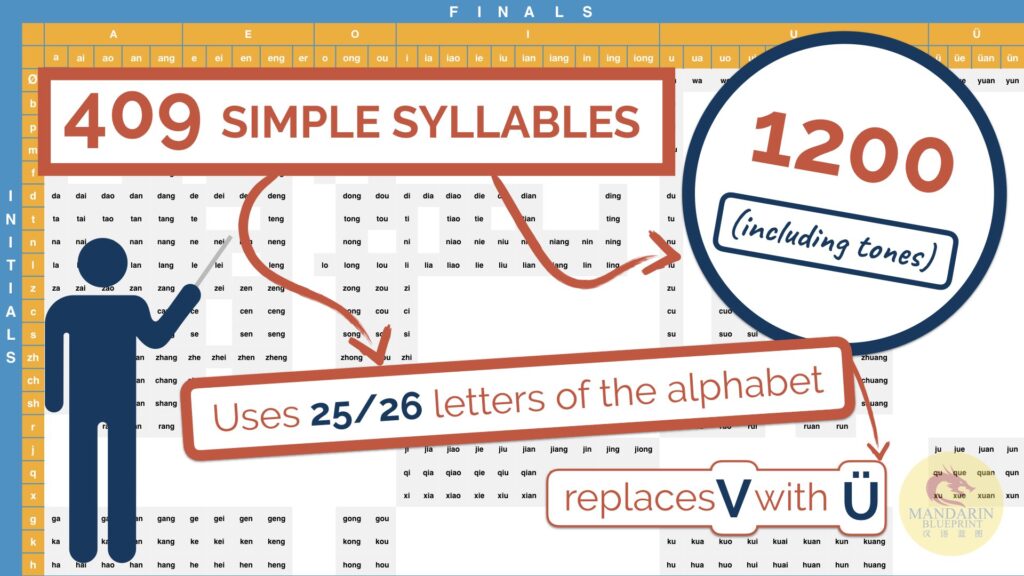
- Chinese Pinyin uses 25 out of 26 letters of the alphabet. The letter Ü replaces V. You’ll notice that on the far right of the chart.
- The top yellow rows on the X-axis represent the categories of finals. The Simple Finals are your main categories, with the compound & nasal finals being subcategories beneath the simple finals. There are 35 finals total.
- The left yellow column on the Y-axis represents the categories of initials. There are 21 initials.
- The top box of the left yellow column has a Ø symbol. This represents the “initial” of the first row of syllables, but there isn’t actually an initial. It is the “Null” initial [LINK].
- The syllables located on the graph are, generally speaking, simply the combination of the initial category & final category
- There are “inconsistencies” when it comes to applying point #5
A Note on Spelling with Tone Marks & in Words
Chinese Pinyin represents how the initials and finals combine, but it doesn’t mention anything about tones. A tone mark ( ¯ ´ ˇ ` ) is placed above one of the vowels of the syllable (never a consonant). Let’s use the syllable “mao” to show how it works:
Examples:
1st tone: māo – a flat line, much like how 1st tone is a flat pitch
2nd tone: máo – a rising line, much like how 2nd tone is a rising tone
3rd tone: mǎo – a line that, like an isolated 3rd tone, goes down and then up
4th tone: mào – a falling line, much like how 4th tone is a falling tone
5th tone: mao – no mark
Which Vowel?
Why was “a” given the tone mark and not “o”? These three rules make it clear:
- If letters “a” or “e” exist anywhere in the syllable, they get the tone mark (they never appear together)
- bēn
- péng
- tài
- qià
- When “o” and “u” are combined to make “ou”, “o” gets the tone mark
- zǒu
- yòu
- In any other combination, it is the final vowel that gets the tone mark
- guī
- xiù
- chǔ
- xú
Multi-Syllable Words
Another important point to note is the correct way to spell multi-syllable words in Pinyin. There is NOT a space between the two syllables. For example, the word “你好” (‘hello’) has a pinyin spelling “níhǎo”. There is no separation between the two syllables.
INCONSISTENCIES OF THE CHINESE PINYIN CHART YOU MUST KNOW
Inconsistencies in Pinyin can fall into two clearly delineated conceptual boxes.
1. The same letters representing different sounds in different syllables
2. The same sound having different spellings in different contexts.
This can be frustrating for beginners, but as with everything in Pinyin, there aren’t that many exceptions to learn in the scheme of things. You’ll also have ample opportunity to solidify this knowledge as you continue to study Mandarin.
The Same Letters Don’t Always Have the Same Sound
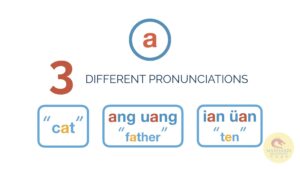
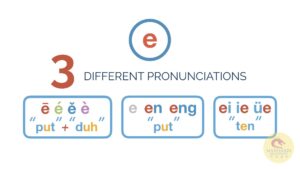
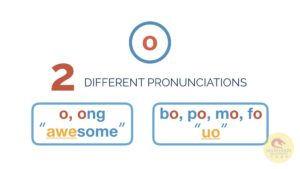
We’ll start this section with a fact about Pinyin: The letter “e” has three different pronunciations depending on the syllable it is in. “Great Scott!” you must be thinking, “Why would Pinyin be so confusing in that way?” Guess what? It also has different pronunciations in English. Ten. English. Evening. Ha, that last one has two different pronunciations of “e” in the same word! The point is, you can’t break Pinyin down at the level of the letter and assume there will be consistency across the language in how it sounds.
This is an article and sounds are audio based, so if you want to learn more about these inconsistencies you can check them out in our Pronunciation Mastery video course. That said, here are a few tips to give you a hint as to what you should be aware of:
- “a” has three different pronunciations.
- “e” has three different pronunciations
- “o” has two different pronunciations
- Nasal finals in the “i” and “ü” section of the Pinyin chart tend to change the pronunciation of vowels
- When the letter “e” is in compound finals, it is easier to say, like the vowel sound of “ten” in English. Simple final E is difficult for non-natives.
- Amongst standard Mandarin speakers, there are two acceptable pronunciations of nasal finals “-in” and “-ing”. The differences are subtle, but it’s there.
As we mentioned, this is not an exhaustive list. We just want you to know what you are getting into. It’s weird…Pinyin fails to be intuitive a lot, but because there are so few overall syllables it is possible to learn everything that’s inconsistent about it.
The Same Sound Spelled Differently in Different Contexts
We mentioned nasal finals “-in” and “-ing” above, which are spelled “Yin” and “Ying” by themselves. What’s up with that?
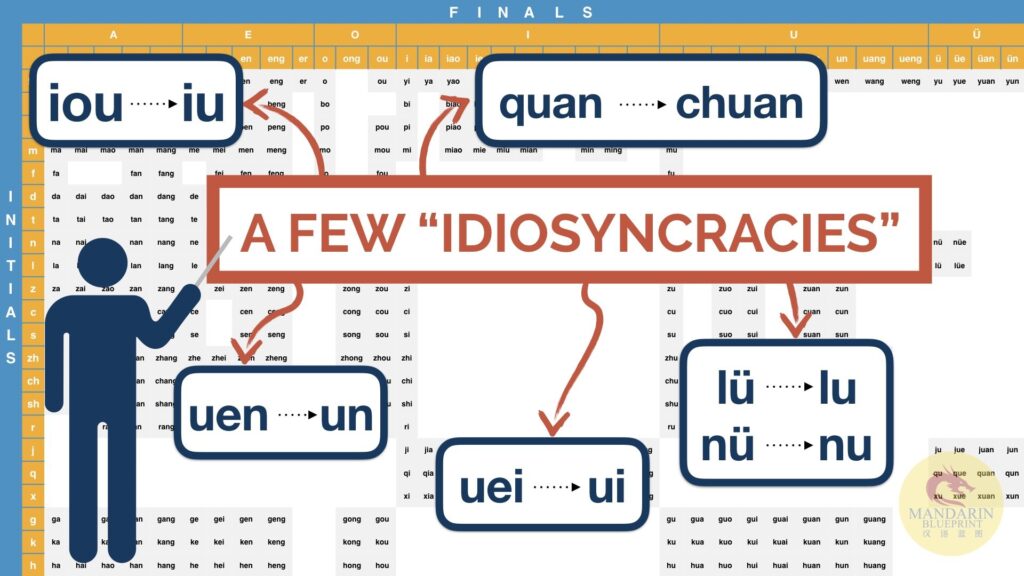
Chinese learners often feel perplexed when considering the spelling choices of the Pinyin creators. Sometimes the exact same sound is spelled differently. There are even silent letters that at first glance seem pointless. It is important to be aware of these moving forward.
The Silent Y & W…and Y again
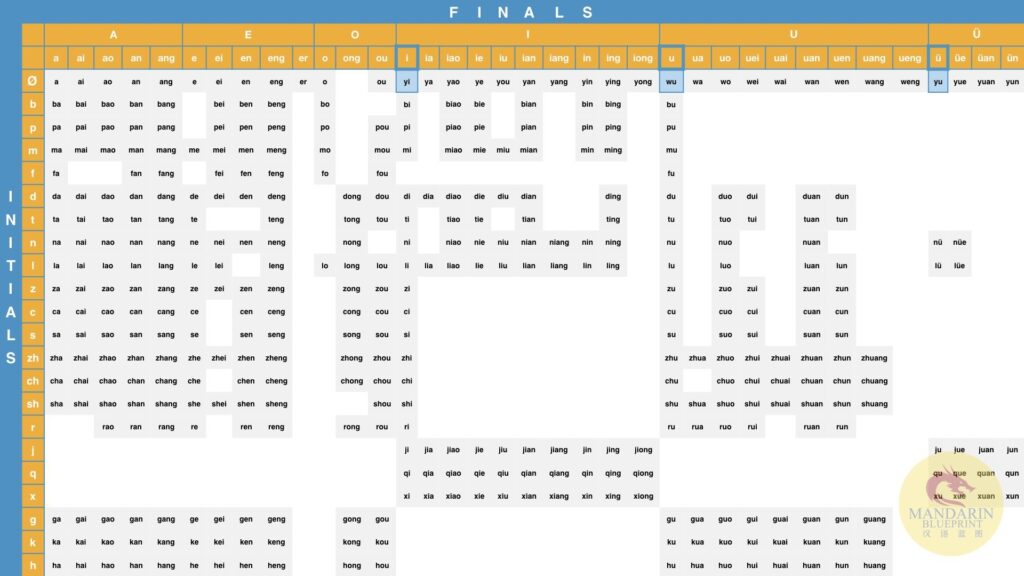
The simple finals i, u & ü aren’t spelled in this way when they are either by themselves or the first letter of a longer syllable. These are rules that affect the “i”, “u” and “ü” sections of the top “null Ø initial” row of the chart.
Here are the rules:
- First, when the letter “i” is a syllable by itself, add a “y” in front of it. The “y” is silent.
- 一 yī
- 移 yí
- 以 yǐ
- 意 yì
- Secondly, when the first letter of a multi letter syllable is “i”, replace it with a “y”. In this context, the “y” is pronounced the same way as “i”. It is simply a placeholder for it.
- 烟 yān (originally “iān”)
- 羊 yáng (originally “iáng”)
- 也 yě (originally iě)
- 要 yào (originally iào)
- **TWO EXCEPTIONS: Nasal finals “-in” and “-ing” are spelled “yin” and “ying” when by themselves, so just like with “yi” the “y” is silent and simply added in front of the the “i”.
- Next, when the letter “u” is a syllable by itself, add a “w” in front of it. The “w” is silent.
- 巫 wū
- 无 wú
- 五 wǔ
- 物 wù
- Similarly to the second rule for “yi”, when the first letter of a multi-letter syllable is “u”, replace it with a “w”. In this context, the “w” is pronounced the same way as “u”. It is simply a placeholder for it.
- 窝 wō (originally uō)
- 完 wán (originally uán)
- 网 wǎng (originally uǎng)
- 外 wài (originally uài)
- In the same way as “yi” and “wu”, when the letter “ü” is a syllable by itself, add a “y” in front of it. The “y” is silent.
- 迂 yū
- 鱼 yú
- 雨 yǔ
- 遇 yù
- Finally, when the first letter of a multi letter syllable is “ü”, add a “y” in front of it. The “y” is silent.
- 约 yuē (originally üē)
- 元 yuán (originally üán)
- 远 yuǎn (originally üǎn)
- 运 yùn (originally ün).
- Note: Some of you may be wondering why the umlaut disappears in these cases, more on that later.
But why though?
As a result of reading these rules, some of you might be wondering, WHY WOULD THEY DO THIS?!?!?! We empathize completely. Here is a way you can think about it:
- Having an isolated letter “i”, “u” or “ü” or a syllable that starts with “i”, “u” or “ü” makes the boundaries between syllables unclear in context.
Example Pinyin sentence comparing when “y, w & y” are added vs. removed:
Removed: uǒ céngjīng ǐuéi xuéxí üián shì méiiǒu ìì de (我曾经以为学习语言是没有意义的)
Added: wǒ céngjīng yǐwéi xuéxí yǔyán shì méiyǒu yìyì de
As you can see, this would be a huge pain in the neck to read if it weren’t for these extra letters. It’s especially hard for the words that require two syllables to be spelled together as a word (i.e. yǐwéi vs, ǐuéi)
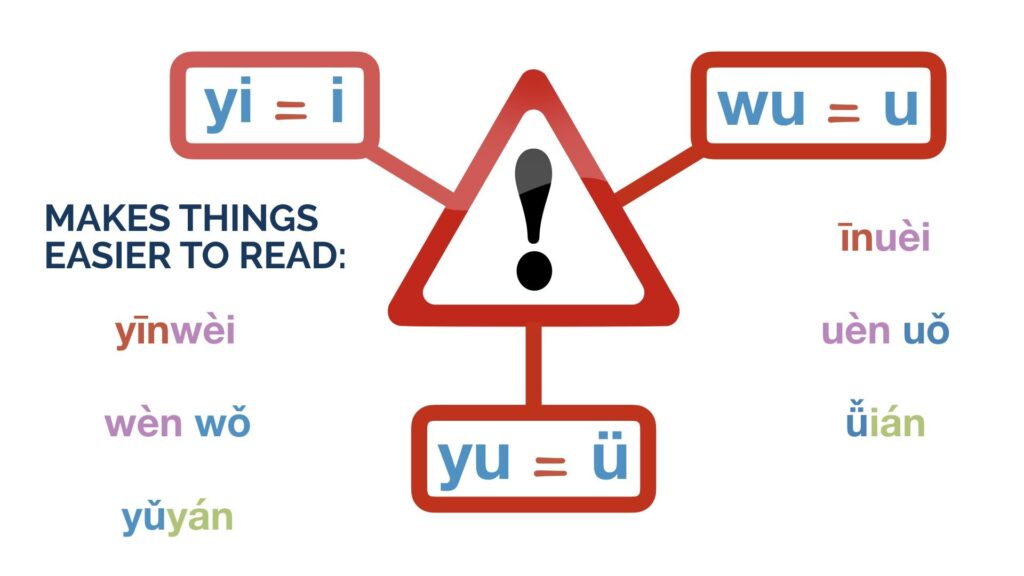
Important Extra Notes About the Chinese Pinyin Letters Y, W & Y
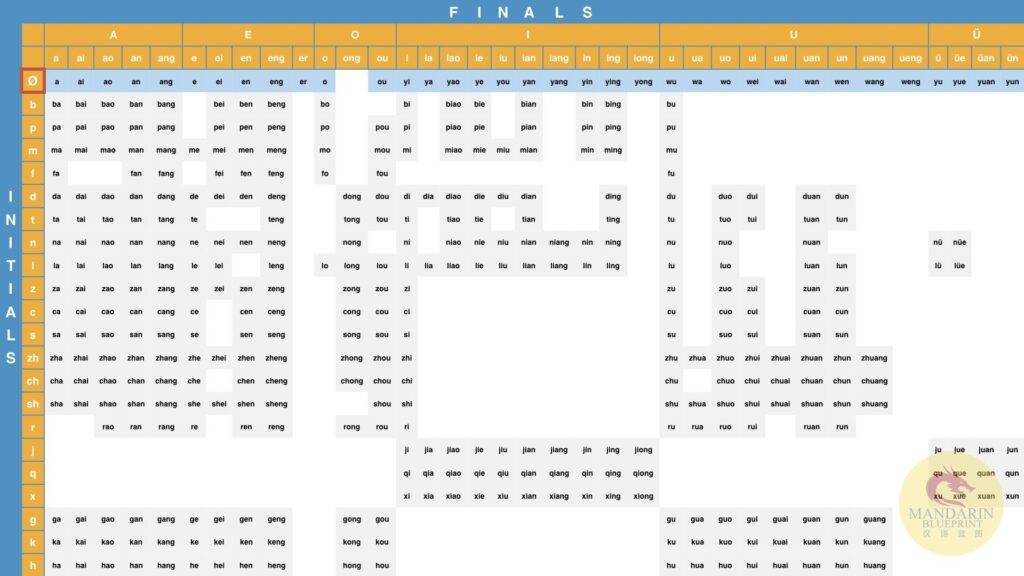
**Only the Ø null initial row displays this phenomenon. Consequently, as soon as you add an initial like “zh-“, “x” or “j-“ in front of one of these pronunciations, they revert back to their spelling of “i”, “u” or “ü”.
Examples:
Ø + u = wu
zh + u = zhu (no need for w)
Ø + uan = wan
zh + uan = zhuan
Ø + i = yi
x + i = xi
Ø + ian = yan
x + ian = xian
Ø + ü = yu
j + ü = ju
Ø + üan = yuan
j + üan = juan
n + u = nu**
n + ü = nü
l + u = lu
l + ü = lü
** What’s up with that last example? Why doesn’t the “ü” keep the umlaut ü in “yu”, “yuan” & “juan”, but keeps it in “nü” & “lü”? The answer is that “l” and “n” are the only initials that get used with both “u” & “ü”. Only 5 initials can combine with “ü” (l, n, j, q, x). “yu” is the spelling when there is no initial (Ø). The remaining three, “j, q & x” never get combined with “u”, only “ü”. Because there is no contradiction, the creators of Pinyin didn’t put the umlaut in “yu, ju, qu, xu”. It is important to know this, because if you don’t you are likely to confuse ‘u’ and ‘ü’.

Finally, “nü, lü, nüe & lüe” are the only four pronunciations in the Chinese alphabet that use the letter “v” when typing. For example, when you want to type the word 女人 nǚrén “woman”, the correct input method is “nvren”.
3 MAJOR OMISSIONS
Pinyin omits letters of important finals three times. Do not be fooled! Articulate these letters as if they are still there.
YOU (IOU)
First of all, the final -iou by itself follows the rule mentioned above of “Ø + iou = you”. So, does “m + iou = miou”? NO! Not in spelling anyway. It is still pronounced as“miou”, but it is spelled “miu”. Pinyin omits the “o”. This is true all the way down the chart.
j + iou = jiu (pronounced jiou)
d + iou = diu (pronounced diou)
q + iou = qiu (pronounced qiou)
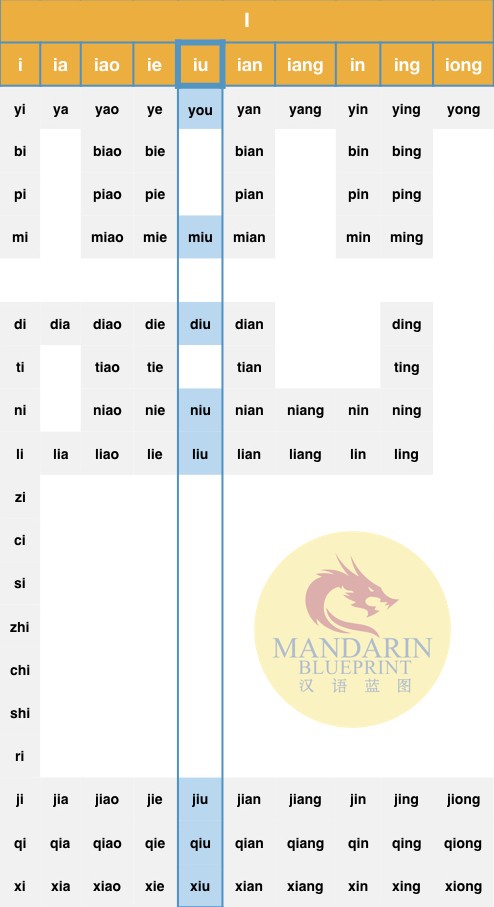
WEI (UEI)
Ø + uei = wei
d + uei = dui (pronounced duei)
g + uei = gui (pronounced guei)
t + uei = tui (pronounced tuei)
h + uei = hui (pronounced huei)

WEN (UEN)
Ø + uen = wen
ch + uen = chun (pronounced chuen)
z + uen = zun (pronounced zuen)
k + uen = kun (pronounced kuen)
s + uen = sun (pronounced suen)
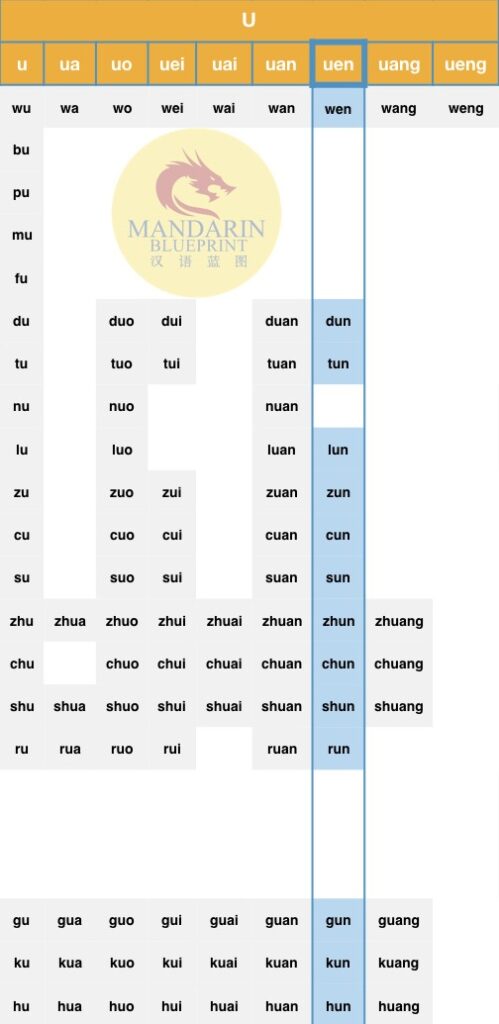
THE FAKE “i”IN CHINESE PINYIN
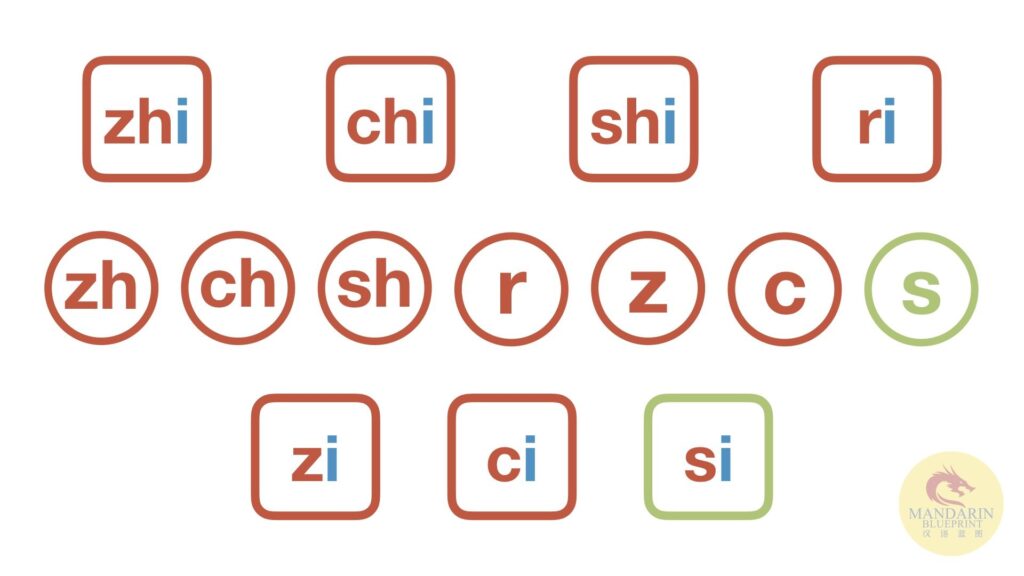
Due to the limited number of letters available in Pinyin, there are seven syllables in Chinese whose “vowel” sound doesn’t sound like anything in English. The spelling of these sounds is “zi, ci, si, zhi, chi, shi, ri”. If you look at your Pinyin chart, they are the seven syllables immediately to the left of the big blank white space in the middle. Apart from these seven, every other time you see the letter “i” in Pinyin, it is pronounced like the “ee” in “see”. However, these syllables are articulated using a different vowel sound. Hence, the “fake” i. Actually, the ‘vowel sound’ (if you can call it that) is even different between “zi, ci, si” & “zhi, chi, shi, ri”. What gives?
Why Choose “i” & Not Another Vowel?
Remember, the creators of Chinese Pinyin had to fit the sounds of Mandarin (round peg) into the English alphabet (square hole). They wanted every syllable to have at least one vowel, and no wonder, can you imagine the official spelling of these syllables being “z, c, s, zh, ch, sh, r”? That would tough to read.
怎么办?Well, the vowels at their disposal were “a, e, i, o, u” and they even added “ü” out of necessity. With that in mind, what other vowel apart from “i” could they have used? A? Nope, “za, ca, sa, zha, cha, sha” are already syllables. Same for “ze, ce, se, zhe, che, she, re” & “zu, cu, su, zhu, chu, shu, ru”. That leaves ‘o’, ‘ü’ & ‘i’ as options, but the first two don’t even come close to sounding like these syllables. As a result, “i” is the only reasonable choice.
YOU CAN MASTER CHINESE PINYIN
The concepts discussed today are not exhaustive in terms of the many idiosyncrasies that exist amongst Pinyin. However, they are the most important to be aware of as you jump deeply into this project, and that is what learning Pinyin is. A project. Furthermore, pronunciation in general never really goes away in terms of your attention and focus as a learner, it simply diminishes in needed energy expenditure over time. That said, as “projects” go, Pinyin is not a big one.
Consider that English has approximately 16,000 distinct syllables. Pinyin has approximately 409, but for the sake of easy math let’s round to 400. Pinyin fits onto one A4 page, implying that English syllables would take up 40 A4 pages (16000 ÷ 400). Holy cats. That would be just plain silly to start learning English by memorizing those 40 A4 pages. In that circumstance, it isn’t even worth thinking about. Chinese though? You would be a fool not to focus a lot on it in the beginning.
GOOD PRONUNCIATION WILL NEVER STOP HELPING YOU
Just think about all the benefits you will being clear on all syllables of the language & how they are said. Here are just a few:
- You will practice correctly. We’ll be the first to say that learning a pronunciation principle doesn’t make you able to produce it, but it does clarify the road to how you practice.
- Avoid practicing incorrectly. Not practicing at all is better than practicing incorrectly in the long run. Engraining mistakes increases the time necessary in the future to fix them. Consequently, your likelihood quit increases as well.
- Actually impress & emotionally move Chinese people. If you show native speakers you’ve taken the time & effort required to re-form your mouth muscles to be able to speak properly, not only will you stand out, the Chinese people around you will be touched that you took their language, and by proxy them, seriously. It gives everyone face, you included.
- The opportunities that open to you will blow you away. The time of Chinese people seeing value in you simply because you are foreign has passed, but that doesn’t mean they aren’t still tremendously curious about a foreign perspective. They just need to understand you. Show Chinese people that you respect them, and everything from friendships, business relationships or even romance will become way more likely. On the flip side, if you have mediocre or poor pronunciation, there is a high probability of awkwardness & disappointment.
Start Now with Chinese Pinyin
So how long does it take to learn the whole Pinyin chart and relevant traps & pitfalls? Depends on you. How many hours a day will you spend on it? We’d say anywhere from a week (super-dedicated) to a couple months (20 minutes a day). It is a great way to get to know the language.
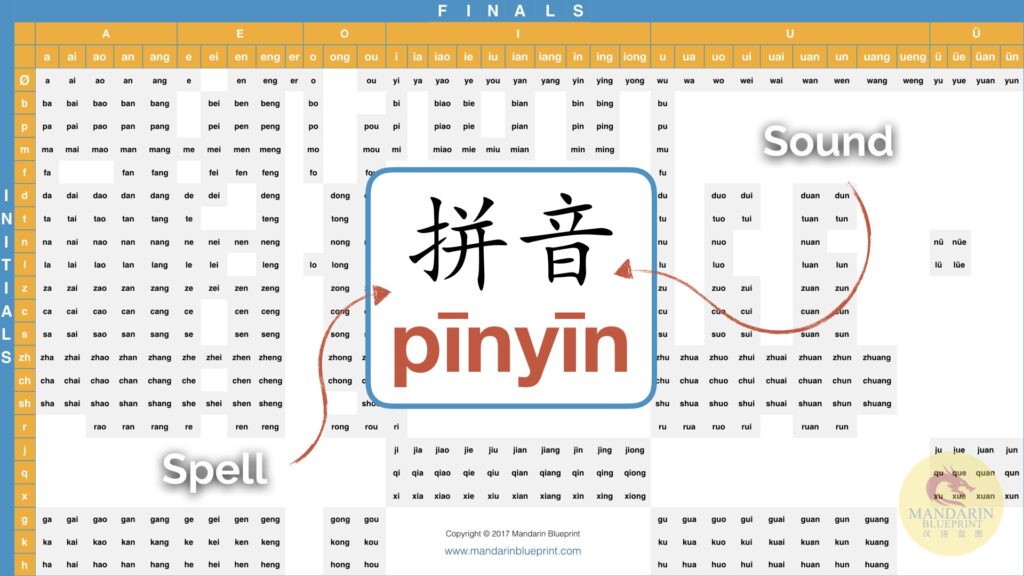
Hey Everyone,
Phil from Mandarin Blueprint here. We wrote this article a while back, so here are some new resources we’ve released more recently (all free):
eBooks:
How to Speak Chinese Like a Native: http://www.mandarinblueprint.com/speak-chinese-like-a-native-ebook/
Chinese Characters 101: http://www.mandarinblueprint.com/chinese-characters-101-ebook/
The Hanzi Movie Method: http://www.mandarinblueprint.com/learn-any-chinese-character-in-less-than-one-minute-ebook/
Video Courses:
Pronunciation Mastery: https://www.mandarinblueprint.com/pronunciation-mastery
The Mandarin Blueprint Method Free Trial: https://www.mandarinblueprint.courses/offers/YozorZwN
Online Seminars:
Rapid Acquisition Crash Course: http://www.mandarinblueprint.com/free-rapid-acquisition-webinar
What is the Mandarin Blueprint Method: http://www.mandarinblueprint.com/mandarin-blueprint-method-webinar
Blog & Podcast:
Blog: https://www.mandarinblueprint.com/blog/
Podcast: https://www.mandarinblueprint.com/podcast/
Podcast with Charlie: https://www.mandarinblueprint.com/podcast/interview-charlie-can-you-trust-mandarin-blueprint/
Enjoy!